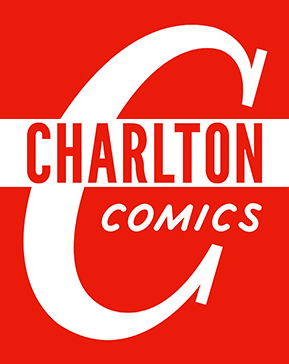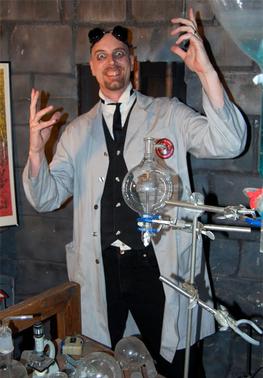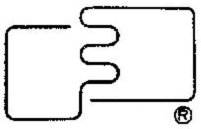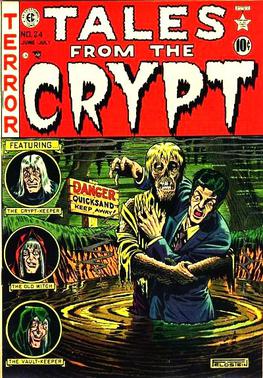Related Research Articles

Marvel Comics is an American comic book publisher and the property of The Walt Disney Company since December 31, 2009, and a subsidiary of Disney Publishing Worldwide since March 2023. Marvel was founded in 1939 by Martin Goodman as Timely Comics, and by 1951 had generally become known as Atlas Comics. The Marvel era began in August 1961 with the launch of The Fantastic Four and other superhero titles created by Stan Lee, Jack Kirby, Steve Ditko, and many others. The Marvel brand, which had been used over the years and decades, was solidified as the company's primary brand.

Charlton Comics was an American comic-book publishing company that existed from 1945 to 1986, having begun under a different name: T. W. O. Charles Company, in 1940. It was based in Derby, Connecticut. The comic-book line was a division of Charlton Publications, which published magazines, puzzle books, and briefly, books. It had its own distribution company.

Fangoria is an internationally distributed American horror film fan magazine, in publication since 1979. It is published four times a year by Fangoria Publishing, LLC and is edited by Phil Nobile Jr.

Famous Monsters of Filmland is an American genre-specific film magazine, started in 1958 by publisher James Warren and editor Forrest J Ackerman.
Derek Graham "Dez" Skinn is a British comic and magazine editor, and author of a number of books on comics. As head of Marvel Comics' operations in England in the late 1970s, Skinn reformatted existing titles, launched new ones, and acquired the BBC license for Doctor Who Weekly. After leaving Marvel UK, Skinn founded and edited Warrior, which featured key works by Alan Moore.
Warren Publishing was an American magazine company founded by James Warren, who published his first magazines in 1957 and continued in the business for decades. Magazines published by Warren include After Hours, Creepy, Eerie, Famous Monsters of Filmland, Help!, and Vampirella.

Castle of Frankenstein was an American horror, science fiction and fantasy film magazine, published between 1962 and 1975 by Calvin Thomas Beck's Gothic Castle Publishing Company, distributed by Kable News. Larry Ivie—who also was cover artist for several early issues—and Ken Beale edited the first three issues. Writer-artist Bhob Stewart edited the magazine from 1963 into the early 1970s. Although promoted and sold as a "monster magazine," readers were aware that Castle of Frankenstein, at the time, was the only nationally distributed magazine devoted to a legitimate and serious coverage of B movies. In addition to its central focus on classic and current horror films, Castle of Frankenstein also devoted pages to amateur filmmakers and fanzines. Its advertising pages sold full-length silent feature films such as The Lost World and The Golem: How He Came into the World.

Kevin Konrad Hanna is an American film director, writer, and artist, known for his work in animation, comics, and video games. He directed the animated film The Clockwork Girl and the acclaimed documentary Mike Mignola: Drawing Monsters, which received significant attention from media sources.

Denis Gifford was a British writer, broadcaster, journalist, comic artist and historian of film, comics, television and radio. In his lengthy career, he wrote and drew for British comics; wrote more than fifty books on the creators, performers, characters and history of popular media; devised, compiled and contributed to popular programmes for radio and television; and directed several short films. Gifford was also a major comics collector, owning what was perhaps the largest collection of British comics in the world.

Basil Gogos was an American illustrator best known for his portraits of movie monsters which appeared on the covers of Famous Monsters of Filmland magazine in the 1960s and 1970s.

George Khoury is a writer and interviewer in the field of comic books. Khoury's most notable works focus on the UK comic book writer Alan Moore. Khoury is based in New Jersey.

The Monster Times was a horror film fan magazine created in 1972. Published by The Monster Times Publishing Co., it was intended as a competitor to Famous Monsters of Filmland. Although the main editorial focus of the magazine was horror media, it also featured articles and reviews of modern and classic science fiction/fantasy films and television series, as well as comic books. Each issue featured a fold-out centerfold poster, usually based on that particular issue's feature story.
David Anthony Kraft was an American comic book writer, publisher, and critic. He was primarily known for his long-running journal of interviews and criticism, Comics Interview, as well as for work for Marvel Comics in the late 1970s and early 1980s.

Dr. Gangrene is a television horror host based in the Middle Tennessee area, played by actor/writer/producer Larry Underwood.

Andy Mangels is an American science fiction author who has written novels, comic books, and magazine articles, and produced DVD collections, mostly focusing on media in popular culture. As an openly gay man, he has been a longtime advocate for greater visibility of gay and lesbian characters in various media, especially comics, including the coordination and moderation of the annual "Gays in Comics" panel for Comic Con International since it was begun in 1988. He is the founder of an annual "Women of Wonder Day" event, which raised over $136,000 in funds for domestic violence shelters and related programs during its seven-year run. As of 2011 he has had three books on the USA Today "best-selling books" list.

FantaCo Enterprises is an American comic book store and publishing company founded and created by Thomas Skulan and based in Albany, New York. As a publisher, FantaCo was known for its idiosyncratic line-up of mostly black-and-white titles, including the humorous Hembeck Series and the horror title Gore Shriek. FantaCo also published "The Chronicles Series", which cataloged top-selling Marvel Comics titles. In its later years, FantaCo published mostly horror comics and a small number of "good girl art".
James Warren is a magazine publisher and founder of Warren Publishing. Magazines published by Warren include Famous Monsters of Filmland, the horror-comics magazines Creepy, Eerie, and Vampirella, the war anthology Blazing Combat, and the science-fiction anthology 1984, among others. Contributors to Warren’s magazines included such significant artists as Neal Adams, Richard Corben, Bernie Wrightson, Johnny Craig, Reed Crandall, Steve Ditko, Frank Frazetta, Russ Heath, Esteban Maroto, Alex Niño, Sanjulián, John Severin, Tom Sutton, Angelo Torres, Al Williamson, and Wally Wood, and writers/editors including Archie Goodwin, Louise Jones, Don McGregor, and Doug Moench. He appointed Billy Graham as the first known African-American art director in mainstream, nationally distributed comic books/comics magazines.

Horror comics are comic books, graphic novels, black-and-white comics magazines, and manga focusing on horror fiction. In the US market, horror comic books reached a peak in the late 1940s through the mid-1950s, when concern over content and the imposition of the self-censorship Comics Code Authority contributed to the demise of many titles and the toning down of others. Black-and-white horror-comics magazines, which did not fall under the Code, flourished from the mid-1960s through the early 1980s from a variety of publishers. Mainstream American color comic books experienced a horror resurgence in the 1970s, following a loosening of the Code. While the genre has had greater and lesser periods of popularity, it occupies a firm niche in comics as of the 2010s.
The House of Hammer was a British black-and-white magazine featuring articles and comics related to the Hammer Film Productions series of horror and science fiction films. The brainchild of Dez Skinn, almost every issue of the magazine featured a comics adaptations of a Hammer film, as well as an original comics backup story, such as the long-running feature Van Helsing's Terror Tales.
References
- ↑ "MICRO-FILM 3". Micro-Film. MF Publications. 4 February 2006. Retrieved 23 August 2016.
- ↑ Hinman, Michael. "Cinescape Magazine to return". Airlock Alpha. Retrieved 23 August 2016.